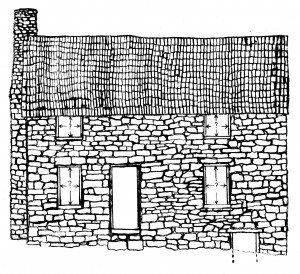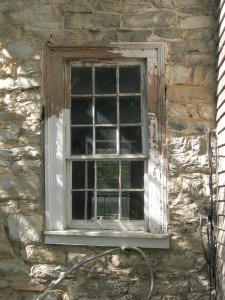In our last post we introduced a depiction of what the Stone House may have looked like after it was first constructed in the early 1760s. (See image below.) Before the log addition was constructed in 1786, the simple one-and-a-half-story stone cabin was all there was to the building. But questions still remain. As we also indicated in the last post, we still do not know about the original size of the window and door openings in the front of the stone side of the structure. At first glance there does not seem to be any indication that the sizes of the windows or door opening have changed. Upon closer examination we could see that the front window and doorjambs were replaced during the early twentieth century. Apart from that there does not appear to be anything out of the ordinary with the rough openings in the front stone wall. Rectangular and squared chisel-cut stones (called ashlar) were used to face the front side of the building. The gables and rear of the structure were built in random-coursed rubble stone with less attention to the facing details. This use of coursed-ashlar stonework in the front of a building was common in the eighteenth century, just as decorative brick and stone facades are customary on houses today. Alterations made to coursed-ashlar stonework are generally easy to spot, especially when the work is done by less skilled masons. The clues to alterations often come in the form of changes to the bedding mortar, interruptions in the historical rhythm of the stone courses, or poorly executed infill accomplished with misshapen or uncut rocks. With the exception of obvious repointing done by twentieth-century masons using Portland cement in the joints around the stones, none of these other clues appear in the visible surfaces of the masonry work around the windows or front door.
So why do we still have concerns about the original size of the window and door openings in the stone side of the structure? The short answer is that they are now too tall and narrow. Our historic structures consultant Doug Reed was the first to notice that something did not fit the pattern. “While the two front first floor windows do not have any readily apparent exterior alterations, the current sizes of the openings do not support any typical size 18th century window known in the region.” He went on to explain the following in the current draft of the historic structure report on the Stone House:
The width of the current opening dictated the use of 6½” to 7” wide glass panes. The width of the sash and glass was also dictated by the rough masonry opening allowing 3½” to 4” wide jambs. For the height to fill the full opening without alterations, a 2” taller piece of glass in ratio to the width again dictated the use of 6½” x 8½” wide glass or the wider glass dimension may have been 7” x 9”. Using those height measurements the sash set that best fit the tall vertical size of the existing rough openings was 9 panes of glass over 9 panes of glass.
Mr. Reed then pointed out that while nine over nine double hung sash windows were possible to make during the period, they would not have been found on a little stone house built in the backcountry of Virginia during the 1760s. He also noted that it was unlikely that these kind of undersized glass panes would be used in a nine over nine double hung sash window, and that it is likely that the rough masonry openings for these front windows were originally shorter. Additionally, he observed that the rough opening for the front door was too narrow for what you would expect to see for a circa 1765 doorway.


The only window and rough opening that does appear to be historically correct and minimally altered is the one on the rear of the stone side. (See photo below.) Facing southeast, this window may be our standard as we move forward with the restoration of the front windows.
